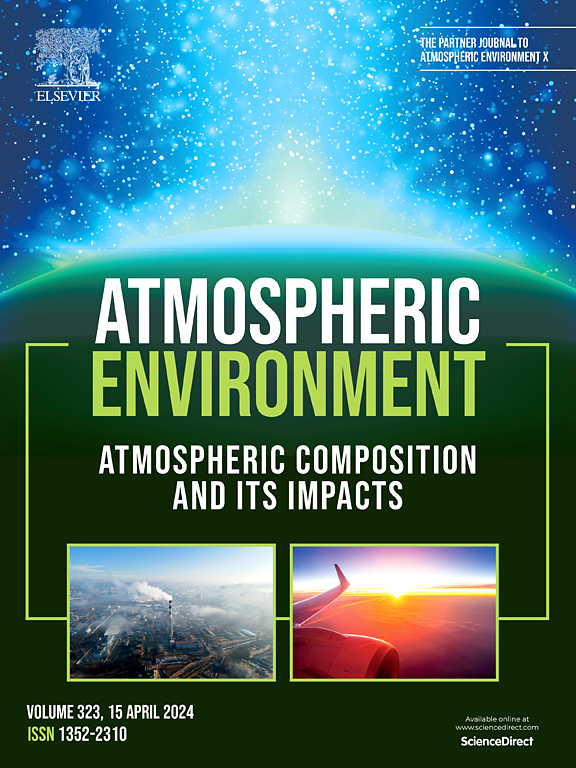High resolution source-resolved PM2.5 spatial distribution and human exposure in a large urban area
IF 4.2
2区 环境科学与生态学
Q2 ENVIRONMENTAL SCIENCES
引用次数: 0
Abstract
Chemical transport models often use moderate spatial resolution to simulate atmospheric pollution, thereby limiting the model's ability to represent variations in urban areas. Additionally, the contributions of individual sources of pollution transported to the urban areas of interest from elsewhere are rarely quantified. In this study, we developed an approach to simulate air quality, focusing on PM2.5 (particulate matter with a diameter lower than 2.5 μm), and its local and regional sources at high spatial resolution of 1 × 1 km2. The approach is applied in the largest city of Greece, Athens. The PMCAMx chemical transport model is employed in combination with the source apportionment algorithm, PSAT (Particle Source Apportionment Technology), to quantify the concentrations and sources of PM2.5, organic aerosol (OA) and elemental carbon (EC) for a typical summer and winter month. A novel approach is developed, allowing the quantification of the contributions of sources not only inside the simulated urban area but also of the regional sources located outside. Model predictions were combined with population distribution data to provide estimations for human exposure not only to total PM2.5 concentrations but also to specific sources within the city. Residential biomass burning and transportation were found to be the dominant local sources of PM2.5 exposure. The higher resolution (1 × 1 km2) offered a more detailed representation of PM2.5 spatial variability than a coarser one (36 × 36 km2). This underscores the importance of capturing local sources in specific areas of the domain. The proposed approach can be used to provide estimates of human exposure to specific local and regional sources of primary and secondary PM2.5 in an urban area.
大城市高分辨率源分辨PM2.5空间分布与人体暴露
化学输运模式通常使用中等空间分辨率来模拟大气污染,从而限制了模式表示城市地区变化的能力。此外,从其他地方输送到有关城市地区的个别污染源的贡献很少被量化。在这项研究中,我们开发了一种模拟空气质量的方法,重点是PM2.5(直径小于2.5 μm的颗粒物),及其在1 × 1 km2的高空间分辨率下的本地和区域来源。这种方法在希腊最大的城市雅典得到了应用。PMCAMx化学输运模型结合源分配算法PSAT(粒子源分配技术),量化了典型夏冬月份PM2.5、有机气溶胶(OA)和元素碳(EC)的浓度和来源。开发了一种新的方法,不仅可以量化模拟城市区域内的源,还可以量化位于外部的区域源。模型预测与人口分布数据相结合,不仅提供了人类暴露于PM2.5总浓度的估计,还提供了城市内特定来源的估计。居民生物质燃烧和交通运输是当地主要的PM2.5暴露源。高分辨率(1 × 1 km2)比粗分辨率(36 × 36 km2)能更详细地表征PM2.5的空间变动性。这强调了在领域的特定区域获取本地资源的重要性。所提出的方法可用于估计人类在城市地区暴露于特定的本地和区域一级和二级PM2.5来源。
本文章由计算机程序翻译,如有差异,请以英文原文为准。
求助全文
约1分钟内获得全文
求助全文
来源期刊

Atmospheric Environment
环境科学-环境科学
CiteScore
9.40
自引率
8.00%
发文量
458
审稿时长
53 days
期刊介绍:
Atmospheric Environment has an open access mirror journal Atmospheric Environment: X, sharing the same aims and scope, editorial team, submission system and rigorous peer review.
Atmospheric Environment is the international journal for scientists in different disciplines related to atmospheric composition and its impacts. The journal publishes scientific articles with atmospheric relevance of emissions and depositions of gaseous and particulate compounds, chemical processes and physical effects in the atmosphere, as well as impacts of the changing atmospheric composition on human health, air quality, climate change, and ecosystems.
 求助内容:
求助内容: 应助结果提醒方式:
应助结果提醒方式:


